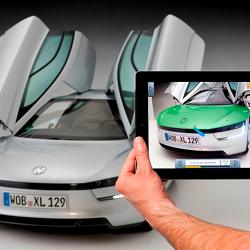
Augmented reality (AR), a technology that superimposes computer-generated images on top of real-world views, is gaining traction as a useful training tool across a wide variety of employee roles, particularly where simulation, training, and skills development are needed.
AR has taken hold in industries including automotive, education, aviation and military, and wherever industrial maintenance is required.
"Training is one of the original usages that researchers pursued in augmented reality,’’ explains Ronald Azuma, who leads the User Experience Research (UXR) group at Intel Labs, because the technology "might make instructions easier to understand by displaying them directly over the real-world objects that require manipulation, thus removing the cognitive load and ambiguity in spatially transforming directions from traditional media, like manuals, text, images and videos, into the situation at hand."
Azuma says AR has the greatest use-potential in 3D tasks such as medical applications and the maintenance and assembly of complex equipment.
People who use AR tools for training have often reported they are better engaged with a process if information that is specific and useful is presented to them for consideration, observers say.
AR differs from virtual reality (VR) in that it superimposes a computer-generated image over something real-world in real time, blending the virtual and the actual. In contrast, VR is an experience in a completely computer-generated virtual environment.
While it has been around for a while, AR hasn’t quite become a disruptive technology just yet, observes Tuong Huy Nguyen, a principal research analyst at Gartner. "The impact and potential are there. In the last 12 or maybe 18 months, we’ve definitely seen more and more interest coming from enterprises to use it as a tool to do things like increase productivity and decrease safety risk, as well as training."
Developer investment in augmented reality applications of all types is on the rise and expected to exceed $2.5 billion in 2018, according to ABI Research, as it becomes a more common part of mobile experiences.
With the success and popularity of consumer-oriented GPS and location-based services, "enterprises started taking note that this is an interesting technology that can deliver real-time [information] in an interesting, relevant way," Nguyen says.
For example, the U.S. Army is looking to incorporate more virtual environments, augmented reality tools, and gaming into training as preparation of troops for major field exercises. The Army Contracting Command in January issued a "Sources Sought" notice requesting information from companies with demonstrated, mature technologies for military training at home bases, including augmented reality tools that could be used by individual soldiers or units smaller than a company (less than 80 soldiers).
Budget constraints have led the military to explore greater use of virtual environments for training, prompting officials to look for simulation solutions. AR is also being used in more "complex situational awareness systems encompassing features such as friend/foe identification, multiple sensory interfaces, location intelligence and interactive battlefield medical support," according to the report "Augmented Reality in the Battlefield 2012 – 2016" by research and consulting firm Mind Commerce.
At Volkswagen, technicians use an AR display system for service information that gives them a better view of the parts (and their positions) inside vehicles, like its hybrid concept car XL1. Using a system called MARTA (Mobile Augmented Reality Technical Assistance) from Metaio, individual parts inside the vehicle are now labeled with text and clear work instructions. In the past, Volkswagen has also used projective AR to create what officials have called a "virtual x-ray vision" for service teams worldwide to see hidden components and structures inside vehicles.
AR is expanding to other types of training as well. At Sheffield Hallam University in the U.K., AR is being used to teach nurse and midwife trainees about empathy and compassion for patients. Computer-generated images of a patient are superimposed onto training mannequins on an iPad to create a "real" patient experience, the university says. Other types of AR training at the university include a simulated operating room and laser technology.
Another added value of augmented reality is the ability to change augmentations in real time, notes David Marimon, CEO of Catchoom, which has an AR image recognition product called CraftAR. Even in remote situations, for example, a trainer can provide timely feedback to a trainee by giving virtual pointers to where and how they should be performing a certain task, he says.
In training, the key to successful repetition depends on visualization of the required task, says Marimon. With virtual reality, the training is limited to a simulated environment, which Marimon says in some cases can be very effective. "However, augmented reality allows the user to feel the exact real environment where the task has to be performed or repeated in the future."
Esther Shein is a freelance technology and business writer based in the Boston area.



Join the Discussion (0)
Become a Member or Sign In to Post a Comment